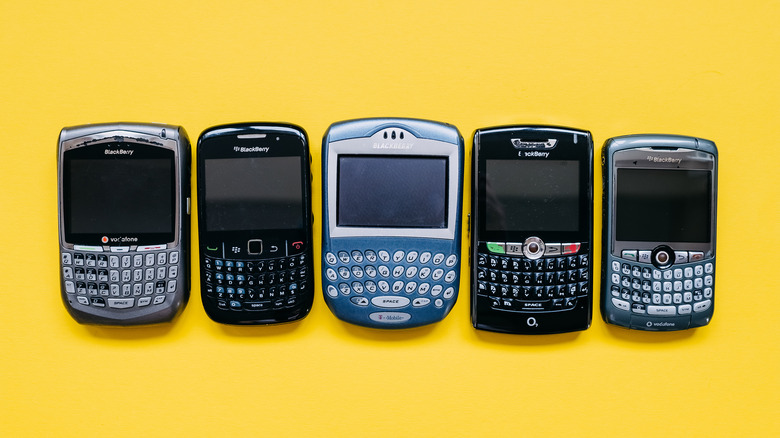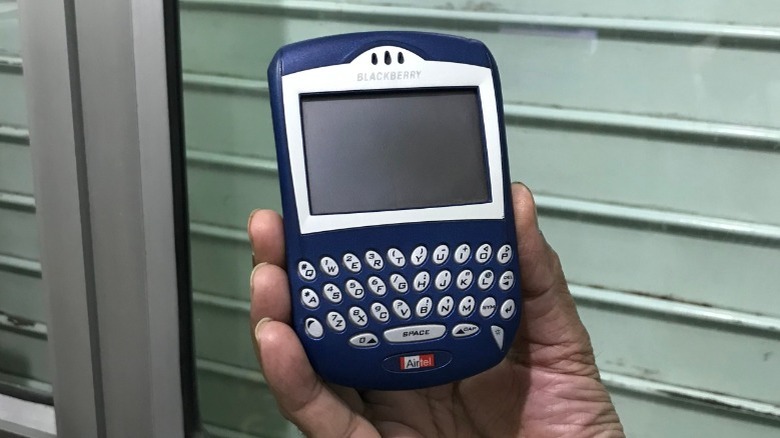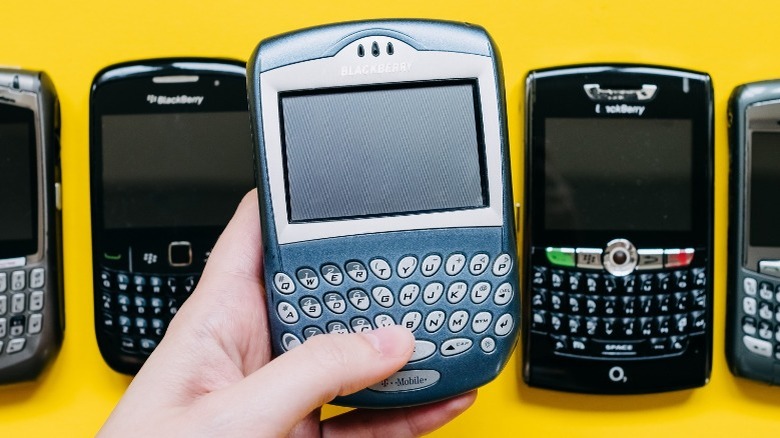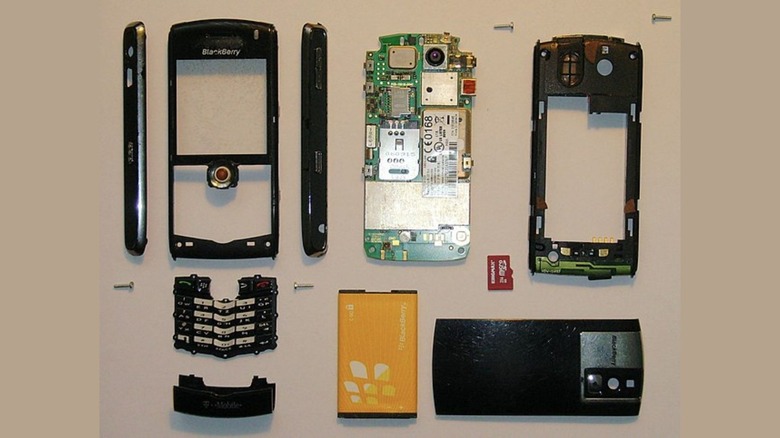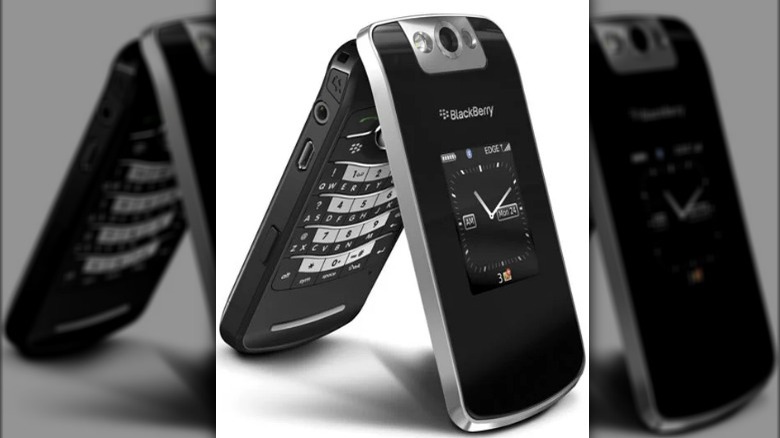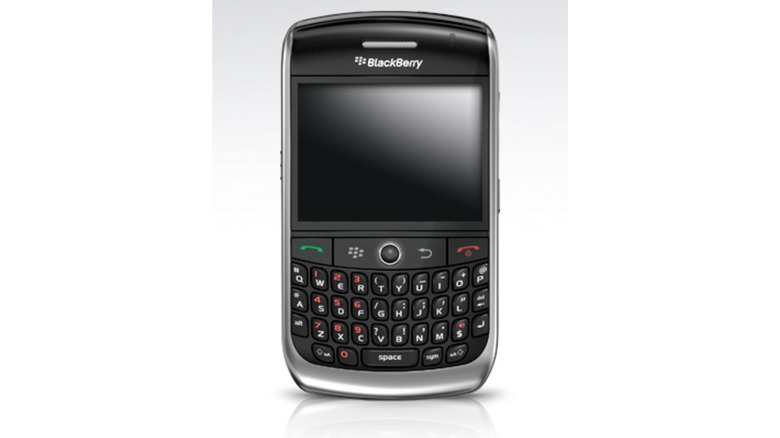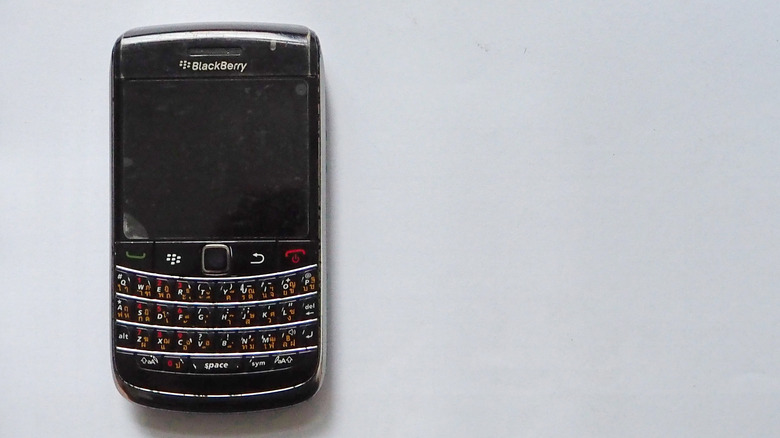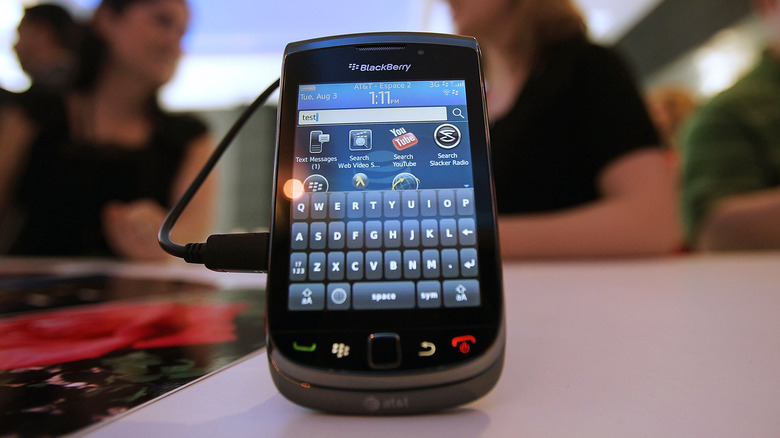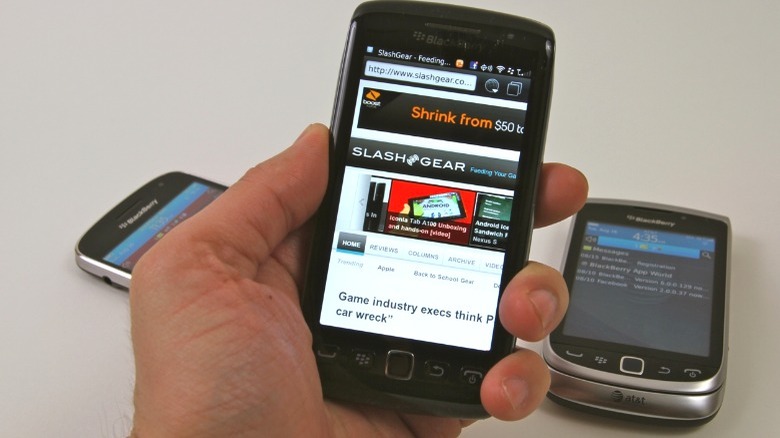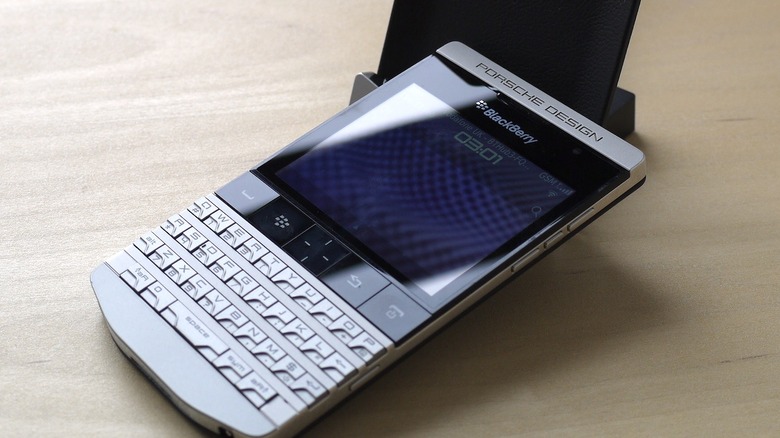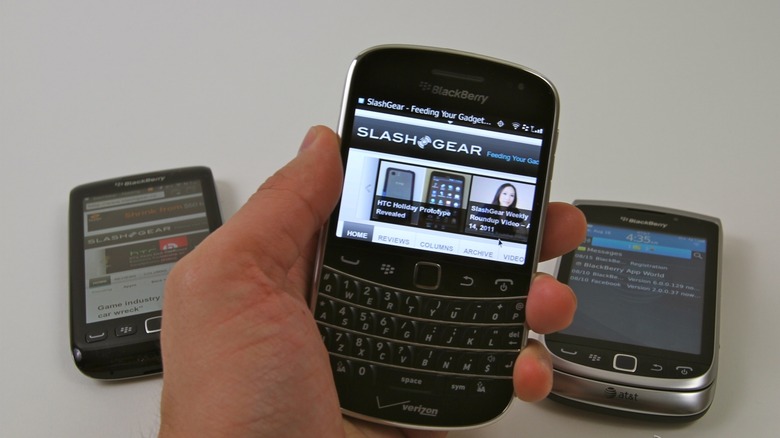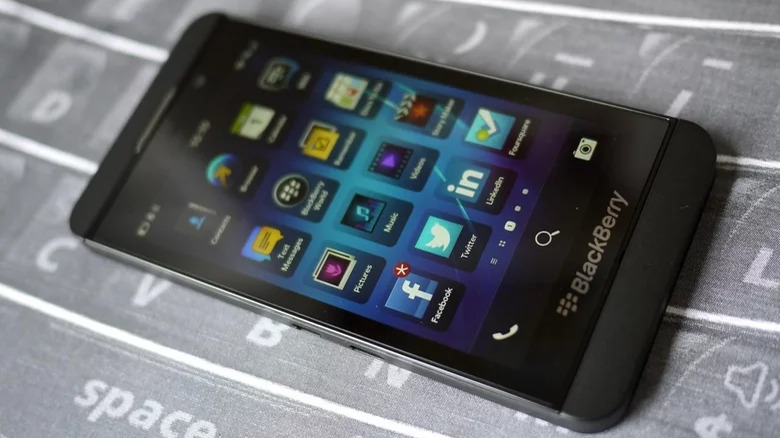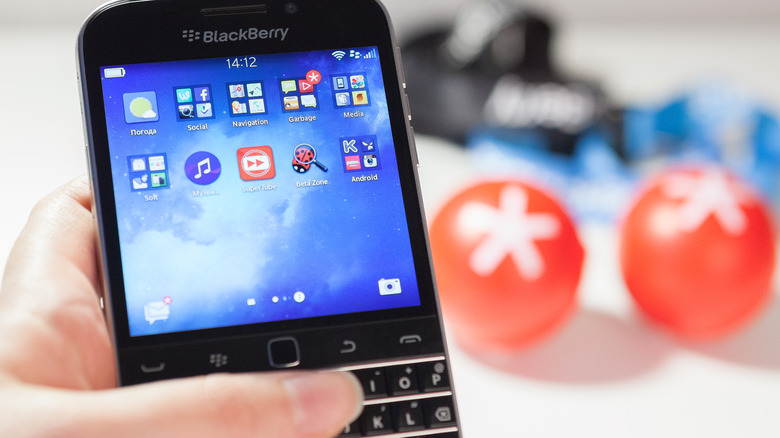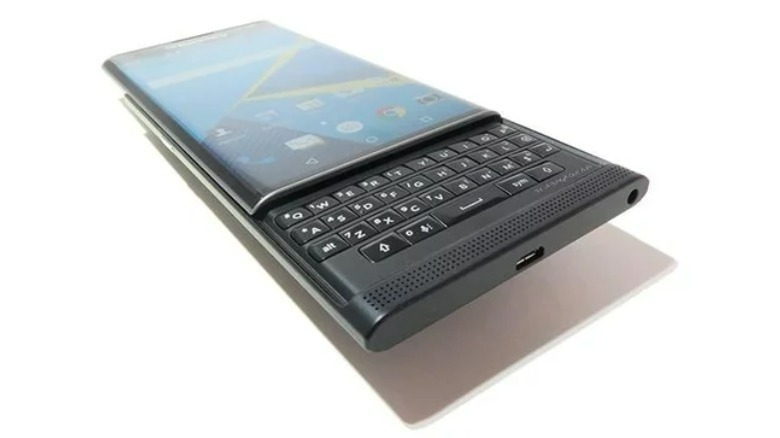The Most Iconic BlackBerry Phones Of All Time
Depending on when exactly you were born, the term "BlackBerry" might conjure up images of pagers, or maybe the classic BlackBerry designed for business professionals, with a screen on the top half and a full QWERTY keyboard on the bottom. For a lucky few, BlackBerry models with a full touchscreen might be the ones you're most familiar with. Regardless of which iconic BlackBerry style defined your generation, BlackBerry phones made an impression on the public that'll last for decades.
The company that developed BlackBerry phones used to be known as Research in Motion, more commonly referred to as RIM, and was founded in 1984. Under the RIM name, it created the BlackBerry brand of pagers, smartphones, and tablets. As the BlackBerry name grew in popularity, the company opted to replace its title in 2013, switching from Research in Motion to BlackBerry.
However, just two years later, the company released its last phone fully developed by BlackBerry Limited — the BlackBerry Priv. TCL, a Chinese company, continued developing and releasing smartphones under the BlackBerry name, but gave up the license in 2020, transferring to OnwardMobility next. Then, BlackBerry Limited announced that all BlackBerry 10 and BlackBerry OS device legacy services would stop operating after January 4, 2022, rendering them pretty useless.
Even though many of these iconic BlackBerry devices can't be used today, it's still pretty awesome to look through the history and evolution of BlackBerry phones, from the Quark 6230 in 2003 to the Priv in 2015.
BlackBerry Quark 6230 (2003)
While there's nothing super impressive about the BlackBerry Quark 6230, it's iconic simply because of its design, with the full QWERTY keyboard paired with smartphone capabilities. The Quark 6230 was one of the most popular first-gen BlackBerry phone models at the time, and the earlier 6210 model was even listed among TIME's All-Time Top 100 Gadgets in 2010.
In addition to the 34-key QWERTY keyboard, the Quark 6230 also boasted a monochrome LCD display. Like many other phones at the time, the Quark 6230 was capable of sending SMS text messages, making phone calls, and browsing the internet via an HTML browser.
It lacked Bluetooth, had to be charged with a proprietary USB cable, and had only 2 MB of static RAM and 16 MB of internal memory, with no card slot to add extra storage via a microSD. But at the end of the day, it was a phone with a cool design that a lot of people wanted to get their hands on.
Blackberry 7230 (2003)
The BlackBerry 7230 was a great option for anyone who wanted a phone as well as integrated support for SMS text messaging, an HTML web browser, and proprietary organizer applications — but only for T-Mobile customers (via T-Mobile). In 2003, email and instant messaging were incredibly popular ways to communicate with family, friends, and co-workers, and the BlackBerry 7230 was capable of doing it all. Some people jokingly call this phone the BlueBerry because of its blue exterior, a stark contrast to the black exterior seen in most previous BlackBerry phones.
It boasted a 33-key QWERTY keyboard — one less key than on the BlackBerry 6230 — and a 2.6-inch display with a 240x160 resolution. The screen could display 65,000 unique colors and help users stay organized with a full-featured calendar, address book, and memo pad. Although you could easily do everything you needed to from the BlackBerry 7230, you could also sync it with your desktop computer for extra efficiency.
Unfortunately, the BlackBerry 7230 wasn't equipped with Bluetooth technology, a speakerphone, or a camera — all of these features would be seen on the BlackBerry Pearl 8100 three years later in 2006. There were other phones at the time with these features, just not BlackBerry's 7230 model. Instead, there was more emphasis on the always-on, push-based access to email accounts, which drew in a specific customer base.
BlackBerry Pearl 8100 (2006)
For the BlackBerry Pearl 8100, the company veered away from its traditional full QWERTY keyboard in favor of a more compact form factor. The Pearl 8100 was even thinner than another popular phone at the time, the Razr V3 from Motorola, but it didn't have a flip feature.
With a modified QWERTY layout on a keyboard with four rows and five columns, along with a display equipped with a 240x260 resolution, the BlackBerry Pearl was aimed toward business professionals as well as everyday cellphone users. One of the biggest selling points of the Pearl 8100 was its built-in media player with support for MP3 ringtones and songs from a memory card.
It had everything people needed in a phone at the time, including an HTML web browser, SMS and MMS text messaging, Bluetooth 2.0, speakerphone capability, and a 1.3-megapixel camera with flash. Then, the Pearl 8100 also provided useful tools like push email notifications, an address book, and a calendar so you could always stay connected.
BlackBerry Pearl Flip 8220 (2008)
The most notable feature of the BlackBerry Pearl Flip 8220 is in its title: It's a flip phone. This was BlackBerry's first flip phone model, and because of this feature, it's commonly referred to as the Pearl Flip or BlackBerry Flip.
The Pearl Flip's predecessor — simply titled the BlackBerry Pearl and released two years prior in 2006 — was the first BlackBerry model with a camera and a media player. Both the original Pearl and the Pearl Flip also featured a 2-megapixel camera, video recording capabilities, predictive SureType text, Bluetooth 2.0, HTML web browsing, and support for a 16 GB microSD card. There were some new features that debuted on the Pearl Flip, including Wi-Fi access and mobile calling via unlicensed mobile access (UMA) support.
The phone could send SMS and MMS texts, load up a few mobile games, customize ringtones with any song or voice note, help you navigate with GPS, and give you up to four hours of talk time with its 900mAh battery. While the Pearl Flip's specs aren't anything special nowadays, it was a pretty decent phone when it first came out and received positive reviews.
BlackBerry Curve 8900 (2009)
Along with the traditional improvements to the operating system, the BlackBerry Curve 8900 boasted a better 3.2-megapixel camera, Wi-Fi capability, and a crisper 480x360 display. In fact, the Curve's display was one of the standout features of SlashGear's review in 2009, along with a solid battery life and an improved web browser.
The Curve 8900 had a trackball that made navigating articles on the web and managing emails much easier than the previous trackpad BlackBerry used on its phones. It improved over the 8300 model from 2007 with Bluetooth 2.0, 256 MB of internal storage, and the introduction of charging via a micro USB port.
For the most part, the Curve 8900 was well-received by the public, but unfortunately, one feature held it back. Other phones around this time were equipped with 3G, but the BlackBerry Curve 8900 only had 2G GSM. For a phone marketed to business-minded individuals, the fact that the Curve 8900 lacked 3G was puzzling.
BlackBerry Bold 9700 (2009)
The BlackBerry Bold 9700 was a significant improvement over the Bold 9000 released a year earlier, in 2008. Its form factor was reduced slightly and the overall design changed to appeal to both men and women. Also, an optical trackpad replaced the trackball, which made searching the web and contacting people a lot easier.
The Bold line of phones is considered to be a high-end alternative to the Curve line, with better specs and more premium hardware materials. BlackBerry's Bold 9700 was equipped with Wi-Fi calling for some carriers, voice dialing, and an updated browser that allowed for HTML browsing, viewing movies or videos from mobile-specific websites, and had RSS feed support.
With a 1500 mAh battery capacity, the BlackBerry Bold 9700 had up to six hours of talk time. It also had a 2.44-inch 480x360 display, a 3.2-megapixel camera, 256 MB of RAM, and internal storage via a microSD slot only, with a 2 GB card included. Then, users could finally rejoice in 3G capabilities! The Bold 9700 supported both 2G GSM and 3G HSPA, which meant faster browsing speeds on the internet and higher download rates.
BlackBerry Torch 9800 (2010)
BlackBerry's Torch 9800 smartphone combined a physical QWERTY keyboard — the classic feature on almost every BlackBerry — with a sliding 3.2-inch 480x360 touchscreen display. The resolution of this display matched many previous BlackBerry models, but the screen gained over an inch because of the sliding feature.
Despite the fact that the Torch 9800 was a great phone, it was a bit overshadowed by the release of the iPhone 4 and the Motorola Droid X, which featured a 1 GHz processor whereas the Torch 9800's processor had a speed of 624 MHz. The Torch 9800 also failed to compete with other brands when it came to a higher display resolution, better video recording capabilities, and the presence of a front-facing camera.
Though it didn't have a front-facing camera, the Torch 9800 did receive major improvements to its rear camera. It now had a 5-megapixel camera with new features like flash, 2x digital zoom, image stabilization, and auto-focus. It had a 1300 mAh removable battery and connectivity options including Bluetooth version 2.1, tri-band 3G/UMTS for AT&T, and quad-band GSM/EDGE. The Torch 9800 was one of the best phones offered by BlackBerry at this point in time, but it just couldn't stack up to other phones on the market.
BlackBerry Torch 9850/9860 (2011)
Thankfully, BlackBerry stepped it up with the Torch 9850 and 9860 models, doing away with the classic QWERTY keyboard and instead debuting a full touchscreen smartphone. This move was more in line with what other brands — like Apple, Google, and Samsung — were offering at the time. The Torch 9850 and 9860 phones had a 3.7-inch TFT LCD display with an 800x480 resolution, and this display was the largest BlackBerry offered until the Z10 was released in 2013.
In addition to the larger display, this Torch smartphone had a multi-touch touchscreen equipped with transmissive TFT LCD technology. Then, the 5-megapixel camera had flash, 4x digital zoom, and allowed for video recording in 720p resolution. Although the battery capacity dropped slightly to 1,230 mAh, the difference was negligible in terms of talk time and overall battery life.
The only difference between the Torch 9850 and the Torch 9860 was the networks each model was compatible with. Both models were compatible with GSM and HSPA networks — although the Torch 9860 had more availability with HSPA network speeds — but only the Torch 9850 was compatible with CDMA networks.
BlackBerry Porsche Design P'9981 (2011)
The BlackBerry Porsche Design P'9981 is the first of three special editions for base BlackBerry devices that had already been released. Porsche Design teamed up with BlackBerry to release a smartphone with a unibody stainless steel frame and leather-covered back panel. Then, the QWERTY keyboard got a sleek makeover. Four rows of metal keys were fit into the steel frame, with a space between each row and custom menu buttons.
The P'9981 is a variant of the BlackBerry Bold 9900, with the same internal hardware components but strikingly different exterior cases. Inside, the P'9981 had 768 MB of RAM, a 5-megapixel rear camera, a 2.8-inch 640x480 touchscreen display, and a Qualcomm Snapdragon MSM 8655 CPU that clocked speeds of 1.2 GHz.
BlackBerry's Porsche Design P'9981 ran BlackBerry OS 7 and, for the most part, the software was identical to BlackBerry's Bold 9900 model. The only difference was a custom user interface created by Porsche Design. Though the P'9981 had a fancier look than the Bold 9900, they were the same on paper.
Future Porsche Design collaborations with BlackBerry resulted in the P'9982 and P'9983 models. The P'9982 was based on the BlackBerry Z10, and the P'9983 was based on the BlackBerry Q10.
BlackBerry Bold Touch 9900/9930 (2012)
This is another BlackBerry release that had two models with different titles, but the only difference is which networks each model is compatible with. The BlackBerry Bold 9930 operated on both GSM and CDMA networks, but the Bold 9900 was only able to function on the GSM network, though in more GSM bands than the Bold 9930 could. Eventually, a 4G LTE version was available with certain carriers.
The BlackBerry Bold Touch 9900 and 9930 were the first two smartphones in the line to have a multi-touch touchscreen display. The 2.8-inch TFT LCD display had a 640x480 resolution. These two Bold Touch models were the thinnest BlackBerry phones to date and equipped with near-field communication (NFC) technology, which allows for communication between two electronic devices from a short distance.
Both the 9900 and 9930 phones had an accelerometer, a digital compass, internal GPS, Bluetooth 2.1, a 1230 mAh battery, a 1.2 GHz Qualcomm Snapdragon processor, and an Adreno 205 GPU. Then, the 5-megapixel camera was capable of 2x digital zoom, flash, and filming video in 720p resolution at 30 frames per second.
BlackBerry Z10 (2013)
The BlackBerry Z10 was a full touchscreen LTE smartphone with more color options than traditional BlackBerrys, including white and a limited red edition in addition to black. It follows the slate phone design, which is a smartphone that has few or no physical buttons, and relies on a touchscreen and virtual keyboard for input instead.
BlackBerry improved all of the internal specs for its Z10 model phone, including the addition of a front-facing camera. The rear camera upgraded to 8 megapixels with the ability to capture video in 1080p resolution, while the 2-megapixel front camera could record 720p videos. Then, the 4.2-inch display had a resolution of 1280x768 and a 15:9 aspect ratio, which was a major upgrade for BlackBerry phones.
The Z10 had 16 GB of flash memory, 2 GB of RAM, up to 64 GB of extra storage via a microSD card, a 1,800 mAh removable battery, and Bluetooth 4.0 capability. In charge of running everything inside LTE versions of the Z10 was Qualcomm's Snapdragon S4 Plus, which had a dual-core CPU running at 1.5 GHz and an Adreno 225 GPU. For places that didn't yet support LTE, the Z10 was equipped with the Texas Instruments OMAP 4470 CPU at the same speed as the S4 Plus.
BlackBerry Classic (2014)
Although the internal specs of the BlackBerry Classic were modern, the external design was reminiscent of older BlackBerry phones. Instead of a full touchscreen display, BlackBerry's Classic phone was equipped with a physical keyboard, optical trackpad, and a touchscreen display, letting users choose their preferred navigation method. The 3.5-inch display was perfectly square and had a 720x720 resolution.
The Classic's design felt retro — especially if you used to own a phone with a similar design, like the BlackBerry Curve — but the specs and suite of apps inside left almost nothing to be desired for users in 2014. The dual-core Qualcomm 8960 processor clocked speeds at 1.5 GHz, and the larger battery provided a healthy amount of talk time, between 11 and 17 hours depending on whether you used 2G or 3G networks.
There was 16 GB of internal storage that could be expanded up to 128 GB with a microSD card, 2 GB of RAM, and a similar camera setup to the BlackBerry Z10. On the front, there was a 2-megapixel camera with auto-focus capability, and on the back, an 8-megapixel camera with all the same features as the Z10.
BlackBerry Priv (2015)
The BlackBerry Priv gave users a large touchscreen display as well as a physical keyboard that could be accessed by simply sliding the display upwards. The 5.43-inch AMOLED display was curved around the sides and had a 2560x1440 resolution. Although the physical keyboard could register sliding gestures across the keys for scrolling, text selection, and autocomplete text suggestions, many users had issues getting these gestures to work.
This was the first BlackBerry smartphone that did not run proprietary BlackBerry OS or BlackBerry 10 platforms. Instead, it adopted Android, with a custom interface and features inspired by traditional BlackBerry devices, like a custom email client.
Also, the Priv had the largest battery and storage capacity on a BlackBerry device to date. Its 3,410 mAh battery was capable of Qi wireless charging, and though it had only 32 GB of built-in storage, you could add extra storage with a microSD card. The camera setup received major upgrades as well, with a 2-megapixel front camera and an 18-megapixel rear camera with the ability to film videos in 4K resolution at 30 frames per second.
With Bluetooth 4.1, a hexacore Snapdragon 808 CPU, and a combination of virtual and physical keyboards, many business professionals loved the BlackBerry Priv. However, some critics at the time noted that the specs on BlackBerry's Priv matched those of its competitors, but the Priv had a much higher price tag.
